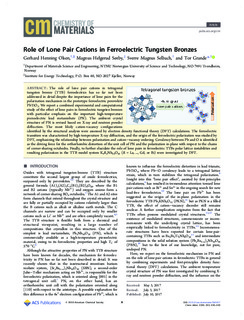| dc.contributor.author | Olsen, Gerhard Henning | |
| dc.contributor.author | Sørby, Magnus Helgerud | |
| dc.contributor.author | Selbach, Sverre Magnus | |
| dc.contributor.author | Grande, Tor | |
| dc.date.accessioned | 2017-09-07T11:20:10Z | |
| dc.date.available | 2017-09-07T11:20:10Z | |
| dc.date.created | 2017-09-05T17:49:33Z | |
| dc.date.issued | 2017 | |
| dc.identifier.citation | Chemistry of Materials. 2017, 29 6414-6424. | nb_NO |
| dc.identifier.issn | 0897-4756 | |
| dc.identifier.uri | http://hdl.handle.net/11250/2453562 | |
| dc.description.abstract | The role of lone pair cations in tetragonal tungsten bronze (TTB) ferroelectrics has so far not been addressed in detail despite the importance of lone pairs for the polarization mechanism in the prototype ferroelectric perovskite PbTiO3. We report a combined experimental and computational study of the effect of lone pairs in ferroelectric tungsten bronzes with particular emphasis on the important high-temperature piezoelectric lead metaniobate (PN). The ambient crystal structure of PN is revised based on X-ray and neutron powder diffraction. The most likely cation-vacancy configurations identified by the structural analysis were assessed by electron density functional theory (DFT) calculations. The ferroelectric transition was characterized by high-temperature X-ray diffraction, and the origin of the ferroelectric polarization was studied by DFT, emphasizing the relationship between polarization and cation–vacancy ordering. Covalency between Pb and O is identified as the driving force for the orthorhombic distortion of the unit cell of PN and the polarization in-plane with respect to the chains of corner-sharing octahedra. Finally, to further elucidate the role of lone pairs in ferroelectric TTBs polar lattice instabilities and resulting polarization in the TTB model system K4R2Nb10O30 (R = La, ..., Gd, or Bi) were investigated by DFT. | nb_NO |
| dc.language.iso | eng | nb_NO |
| dc.publisher | American Chemical Society | nb_NO |
| dc.title | Role of Lone Pair Cations in Ferroelectric Tungsten Bronzes | nb_NO |
| dc.type | Journal article | nb_NO |
| dc.type | Peer reviewed | nb_NO |
| dc.description.version | acceptedVersion | nb_NO |
| dc.source.pagenumber | 6414-6424 | nb_NO |
| dc.source.volume | 29 | nb_NO |
| dc.source.journal | Chemistry of Materials | nb_NO |
| dc.identifier.doi | 10.1021/acs.chemmater.7b01817 | |
| dc.identifier.cristin | 1491194 | |
| dc.relation.project | Norges forskningsråd: 209337 | nb_NO |
| dc.relation.project | Notur/NorStore: NN9264K | nb_NO |
| dc.description.localcode | © 2017 American Chemical Society. This is the authors' accepted and refereed manuscript to the article. Locked until 10 July 2018 due to copyright restrictions. | nb_NO |
| cristin.unitcode | 194,66,35,0 | |
| cristin.unitname | Institutt for materialteknologi | |
| cristin.ispublished | true | |
| cristin.fulltext | postprint | |
| cristin.qualitycode | 2 | |
